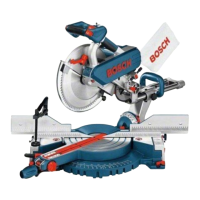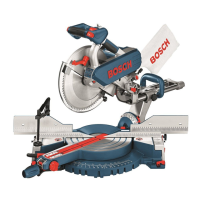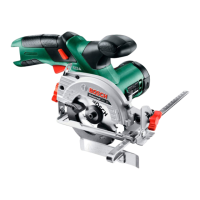English | 13
Bosch Power Tools 1 609 92A 08V | (27.5.13)
– Push the locking lever 1 and slide the retracting blade
guard 4 and the cover plate 21 back under the fastening
screw 27.
– Slowly guide the retracting guard blade 4 downwards until
the saw blade is completely covered again.
– Retighten the fastening screws 27 and 26.
Operation
Before any work on the machine itself, pull the mains
plug.
Transport Safety (see figure C)
The transport safety-lock 14 enables easier handling of the
machine when transporting to various working locations.
Releasing the Machine (Working Position)
– Push the tool arm by the handle 16 down a little in order to
relieve the transport safety-lock 14.
– Pull the transport safety-lock 14 completely outward.
– Guide the tool arm slowly upward.
Note: When working, pay attention that the transport safety-
lock is not pushed inwards. Otherwise, the tool arm cannot be
lowered to the requested depth.
Securing the Machine (Transport Position)
– Guide the tool arm downward until the transport safety-
lock 14 can be pushed completely inward.
For additional information on transport, see page 15.
Preparing for Operation
Extending the Saw Table (see figure D)
Long workpieces must be underlaid or supported at their free
end.
The saw-table can be extended leftward using the saw-table
extension 11.
– Fold the clamping lever 10 downwards.
– Pull out the saw-table extension 11 to the desired length.
– To lock the saw-table extension, pull the clamping lever 10
back up.
Adjusting the Cutting Angle (see figure E)
The miter angle can be set in a range from 0° to 45°.
Frequently used mitre angles are identified on the angle stop
6 with appropriate markings. The 0° and 45° position are set
at the respective end stop.
– Loosen the tension handle 13 of the angle stop 6.
–Turn the angle stop 6 until the angle display 33 indicates
the desired miter angle on the scale 34.
– Retighten the tension handle 13.
Marking the Cutting Line (see figure F)
A laser beam indicates the cutting line of the saw blade. This
allows for exact positioning of the workpiece for sawing, with-
out having to open the retracting blade guard.
– For this, switch the laser beam on with the switch 19.
– Align the cutting mark on your workpiece with reference to
the right-hand edge of the laser line.
Note: Before sawing, check if the cutting line is still indicated
correctly (see “Adjusting the Laser”, page 14). The laser
beam, as an example, can misadjust due to vibrations after in-
tensive use.
Clamping the Workpiece (see figure G)
To ensure optimum working safety, the workpiece must al-
ways be firmly clamped.
Do not saw workpieces that are too small to clamp.
Long workpieces must be underlaid or supported at their free
end.
– Place the workpiece against the angle stop 6.
– Slide the clamping spindle 7 against the workpiece and
firmly clamp the workpiece with the spindle handle 9.
Loosening the Workpiece
– Loosen the spindle handle 9.
– Tilt up the quick release 8 and pull the clamping spindle 7
away from the workpiece.
Working Advice
General Sawing Instructions
Protect the saw blade against impact and shock. Do not sub-
ject the saw blade to lateral pressure.
Do not saw warped/bent workpieces. The workpiece must al-
ways have a straight edge to face against the fence.
Long workpieces must be underlaid or supported at their free
end.
Permissible Workpiece Dimensions
Maximal workpiece sizes:
Minimal workpiece sizes
(= all workpieces that can be clamped via the clamping spin-
dle 7):
Length 80 mm
Cutting depth, max. (0°/0°): 115 mm
Mitre/Bevel Angle
Workpiece Form 0° 45°
115 Ø 90 Ø
100 x 100 85 x 85
158 x 80 85 x 85
110 x 110 85 x 85
OBJ_BUCH-1939-001.book Page 13 Monday, May 27, 2013 2:14 PM

